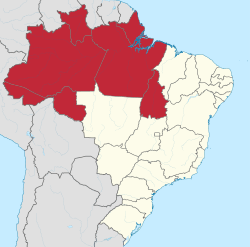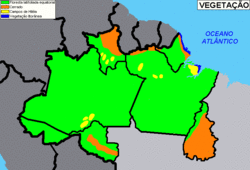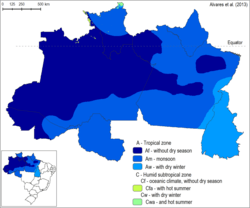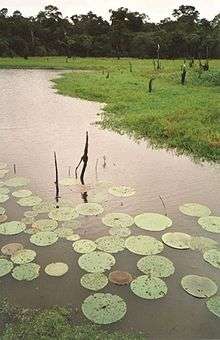North Region, Brazil
| North Region Região Norte | |
|---|---|
| Region | |
 Location of North Region in Brazil | |
| Coordinates: 3°7′45″S 60°1′17″W / 3.12917°S 60.02139°WCoordinates: 3°7′45″S 60°1′17″W / 3.12917°S 60.02139°W | |
| Country |
|
| States | AC, AP, AM, PA, RO, RR and TO |
| Area | |
| • Region | 3,853,327.2 km2 (1,487,777.9 sq mi) |
| Area rank | 1st |
| Population (2005 census) | |
| • Region | 14,726,059 |
| • Estimate (2007) | 15,022,060 |
| • Rank | 4th |
| • Density | 3.8/km2 (9.9/sq mi) |
| • Density rank | 5th |
| • Urban | 75.6% |
| GDP | |
| • Year | 2005/2006 estimate |
| • Total | R$120 billion (5th) |
| • Per capita | R$7,247 (4th) |
| HDI | |
| • Year | 2005–2006 |
| • Category | 0.764 – medium (4th) |
| • Life expectancy | 71 years (4th) |
| • Infant mortality | 25.8 per 1,000 (2nd) |
| • Literacy | 88.7% (4th) |
| Time zone | BRT (UTC-04) |
| • Summer (DST) | BRST (UTC-03) |
The North Region of Brazil (Portuguese: Região Norte do Brasil) is the largest Region of Brazil, corresponding to 45.27% of the national territory. It is the least inhabited of the country, and contributes with a minor percentage in the national GDP and population. It comprises the states of Acre, Amapá, Amazonas, Pará, Rondônia, Roraima and Tocantins.
Its demographic density is the lowest in Brazil considering all the regions of the country, with only 3.8 inhabitants per km2. Most of the population is centered in urban areas.
Belém International Airport and Manaus International Airport connect the North Region with many Brazilian cities and also operate some international flights.
The North is home to the Federal University of Amazonas and Federal University of Pará.
Geography


The Amazon represents over half of the planet's remaining rainforests and comprises the largest and most species-rich tract of tropical rainforest in the world.
Wet tropical forests are the most species-rich biome, and tropical forests in the Americas are consistently more species rich than the wet forests in Africa and Asia.[2] As the largest tract of tropical rainforest in the Americas, the Amazonian rainforests have unparalleled biodiversity. More than 1/3 of all species in the world live in the Amazon Rainforest.[3]
The region is home to about 2.5 million insect species, tens of thousands of plants, and some 2000 birds and mammals species. To date, at least 40,000 plant species, 3,000 fish, 1,294 birds, 427 mammals, 428 amphibians, and 378 reptiles have been scientifically classified in the region.[4] Scientists have described between 96,660 and 128,843 invertebrate species in Brazil alone.[5]
The diversity of plant species is the highest on earth with some experts estimating that one square kilometre may contain over 75,000 types of trees and 150,000 species of higher plants. One square kilometre of Amazon rainforest can contain about 90,790 tonnes of living plants.[6] This constitutes the largest collection of living plants and animal species in the world. One in five of all the birds in the world live in the rainforests of the Amazon. To date, an estimated 438,000 species of plants of economic and social interest have been registered in the region with many more remaining to be discovered or catalogued.[7]
Political Subdivisions

| City | Population (2007) |
|---|---|
| Manaus | 1,612,475 |
| Belém | 1,408,847 |
| Ananindeua | 484,600 |
| Porto Velho | 426,558 |
| Macapá | 368,397 |
| Rio Branco | 288,614 |
| Santarém | 274,074 |
Ethnic groups
The population of northern Brazil is largely made up of Caboclos, descendants of Indians and Europeans - mostly Portuguese, French and Spanish. North of Brazil has received and continues to receive large migration of people from South and Southeast of the country. In the 20th century, the North also received great migration from the Northeast, who were working in the rubber plantations of Amazonas and Acre.
| Skin color/Race (2006) | |
|---|---|
| White (European, Caucasian) | 23.9% |
| Black (African) | 6.2% |
| Brown (Multiracial) | 69.2% |
| Yellow (Asian) | 0.49% |
| Red (Amerindian) | 0.7% |
Economy
The economy of the North Region is essentially based on the vegetal plantation and extraction, such as latex, açaí, woods and nuts; and mineral extraction of gold, precious stones, cassiterite and tin (metal); as well as mining exploitation, mainly iron, at Carajás Mountain Range (in the State of Pará) and manganese, at Navio Mountain Range (in the State of Amapá).
Infrastructure
Vehicles: 1,746,501 (March/2007); Telephones: 1,805,000 (April/2007); Cities: 449 (2007).
Portuguese language is the official national language, and thus the primary language taught in schools. But English and Spanish are part of the official high school curriculum.
Educational Institutions
- Universidade da Amazônia (UNAMA);
- Universidade do Estado do Pará (UEPA);
- Universidade Federal do Amazonas (UFAM);
- Universidade Federal do Pará (UFPA);
- Universidade Federal de Rondônia (UNIR);
- Universidade Federal do Acre (UFAC);
- Universidade Federal do Amapá (UNIFAP);
- Universidade Federal de Roraima (UFRR);
- Universidade Federal do Tocantins (UFT);
- Universidade do Estado do Amazonas (UEA);
- and many others.
Transportation
There are only a few highways in the North region. The most important ones are the Trans-Amazonian highway, running through Amazonas, Pará, Piauí, Maranhão, Rodovia Belém-Brasília, Federal District, Goiás, Tocantins, Maranhão. Most of the transportation on the region is done by boat or airplane, mainly in the state of Amazonas. There are two major airports in the region: Belém International Airport, serving Belém, and Eduardo Gomes International Airport, serving Manaus.
References
- ↑ Alvares, C. A., Stape, J. L., Sentelhas, P. C., de Moraes, G., Leonardo, J., & Sparovek, G. (2013). Köppen's climate classification map for Brazil. Meteorologische Zeitschrift, 22(6), 711-728.
- ↑ Turner, I.M. 2001. The ecology of trees in the tropical rain forest. Cambridge University Press, Cambridge. ISBN 0-521-80183-4
- ↑ "Amazon Rainforest, Amazon Plants, Amazon River Animals". World Wide Fund for Nature. Retrieved 2007-11-26.
- ↑ Da Silva et al. 2005. The Fate of the Amazonian Areas of Endemism. Conservation Biology 19 (3), 689-694
- ↑ Lewinsohn, Thomas M.; Paulo Inácio Prado (June 2005). "How Many Species Are There in Brazil?". Conservation Biology. 19 (3): 619–624. doi:10.1111/j.1523-1739.2005.00680.x.
- ↑ Photos / Pictures of the Amazon Rainforest
- ↑ The Amazon Rainforest
